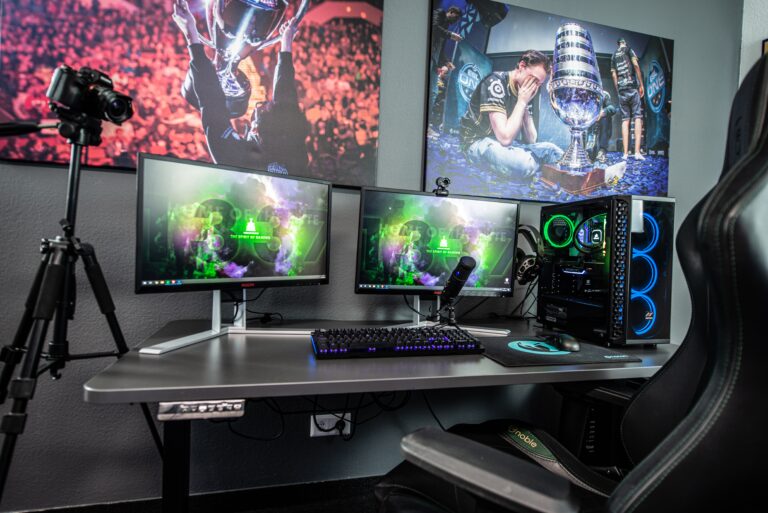Future of Video Games: Trends, Technology, and Types

Current Video Game Trends
Since they first became popular in the 1980s, video games have gone a long way. However, recent technological developments have made the future of gaming even more promising. Here are a few real-life instances to illustrate this point.
1. Avatar Creation
As a result of advances in 3D scanning and face recognition software, it is now possible to construct an avatar that looks exactly like you in the gaming world, or to creatively transfer your own facial expressions to other digital creations.
2. Voice Recognition
That controller is lying around collecting dust. It’s all good! Computers now readily understand user orders when they are given by voice. Although voice-controlled gaming has been around for a long time, its real-world potential has only just been realized. Additionally, you may manage games, communicate with social media, play music from your collection, or search the internet all by speaking to your console.
3. Gesture Control
With Intel RealSense technology, you can play first-person shooter games or just interact with your smartphone by waving your hand about. For gamers, gesture control lets you manage your gaming experience through the use of 22 locations on your hand tracked by a 3D camera.
Warrior Wave, for example, makes use of RealSense technology so that you may guide a bunch of Ancient Greek soldiers to safety using the contour of your hand.
4. Astonishing Graphics
We have come a long way since the days of 8-bit graphics. Gamers are now able to enjoy games in fully created environments with picture-realistic graphics thanks to cutting-edge improvements. To make the game more enjoyable to play, greater visual quality is been used to enhance the immersion.
5. Ultra High Resolution Displays
When the visuals in a video game are this excellent, it’s important to have a means to show them off. Enter the world of ultra-high-definition gaming. The price of 4K televisions and laptops has constantly fallen, making this format the ultimate norm in how we watch the games we play.
You thought 1080p was impressive? 4K televisions support at least 4,000 pixels. And that’s not the best we can go.
6. Better Immersion
Despite the fact that many virtual reality gaming consoles have yet to be commercially released, those working on VR headset displays are well on their way to giving gamers an immersive metaverse gaming experience like no other.
Conversely, if you’re not a fan of the virtual world, why not play some games in ours? AR (Augmented Reality) games let you see the world from a perspective that isn’t limited by a TV or computer monitor. You move around the actual world and apply the game’s goal to real-life scenarios. Use your outdoor obstacles to map out puzzles or play table hockey from any position on your kitchen counter.
7. Smart Wearables
Smartwatches, eyewear, and other wearable gaming devices allow gamers to play on the go without becoming too intrusive. Wearable technology companies that started out with fitness applications are now looking to bring entertainment into the mix. When it comes to wearables, you’re not only extending your body; you’re also extending your game consoles as well.
8. Cloud Gaming
By using the cloud rather than hardware, companies are attempting to reduce the burden on gamers. Games are no longer constrained by the storage capacity of discs or consoles. Games may be streamed directly to your computer screen through the Internet if they use the cloud, which allows for less hardware needing to be purchased by the gamer.
What about game broadcasts? The ability to broadcast video games is becoming more and more mainstream, much like similar movie streaming services.
Video Game Trends That Will Shape the Future
So, these are the primary tendencies that we’ve noticed, all of which have the potential to have a significant impact on the way games are designed and played in the not too distant future:
1. Gaming advocates are parents
Alison York, Nickelodeon’s research director, spoke on how the first generation of parents who grew up playing games themselves are now passing that enthusiasm and expertise on to their children during her talk on the gaming habits of modern teens. Surveys of several households indicated that 75 percent of parents now play video games with their children and that youngsters under the age of 10 rely heavily on their parents for gaming advice.
2. The ability to move in all directions at the same time
Three-quarters of youngsters under the age of 11 have a tablet, according to Nickelodeon’s data, and kids are increasingly getting their first cellphones when they begin secondary school. By smoothly moving between digital and real life, this “swipe generation” is able to do so, York explains. People want a 360-degree experience, in which each platform contributes something unique. This is a future trend to look out for.
3. 3D prints become a little “physical”
Toys that relate to or interact with video games will likely no longer be restricted to large companies like Activision and Disney, as 3D printing becomes more affordable. Currently, Sandbox, which makes it simpler for game developers to produce and share models based on their titles, is already growing in popularity.
NFC (near-field communication) technology is also getting more inexpensive, which might lead to a greater range of 3D-to-life experiences.
4. Players are the architects of their own experiences
Gamers will not only be able to observe future progress, but they will also be able to participate in it. A growing number of Kickstarter campaigns provide donors the opportunity to participate in the creative process of the project by participating in the game as voice actors or contributing to the music composition. The introduction of easy-to-use map editors, such as Mario Maker, Hotline Miami 2, and Doom, means that gamers will be able to design their own levels and upload them to the web.
Player-created content has long been a feature of the PC gaming landscape, but it may soon be making its way into the console market, allowing companies to effectively outsource the creation of new content to their most ardent fans. Steam Workshop, which allows PC gamers to sell their modifications to one other, may perhaps become a widespread feature in the future.
5. Popular games becoming businesses and platforms in their own right
Mobile game makers like Rovio, Zynga and SuperCell have demonstrated how, rather than releasing regular sequels; they’ve made their games into platforms by responding to analytics data, customizing difficulty, and then providing downloadable additions to their major brands. This mindset is currently being incorporated into the mainstream creation of console and PC games.
Retaining clients is simpler than attracting new ones, especially as the number of acquisition methods grows. Retention lines are beginning to appear on the current generation of consoles as many games adopt free-to-play.
6. Keeping trolls under control
Developers and studios are exposed to an increasing degree of hostility and abuse as the number of interactions between them grows. In the future, understanding how to deal with this flood will be an essential part of producing games.
7. For the first time, virtual and augmented reality are commercially viable
Virtual reality headsets such as the Oculus Rift have the potential to fundamentally alter the gaming experience for users. Both Microsoft and Google are working on augmented reality headsets. Additionally, there is a large community of developers who are testing the technology, solving some of the technical issues, and developing design standards that will lead to new (and non-nauseous) experiences in the near future. Also, big publishers like Ubisoft have stepped up their research in the field.
As large firms scramble to build their own virtual-reality apps, there might be a significant spike in sales for game creators. Venture capitalists and angel investors appear to be flooding the market as a result of this.
Conclusion
Since the beginning, the video game business has been driven by new ideas and concepts. It’s just a matter of time before we encounter brand-new devices, interfaces, and experiences. Streaming services and mobile phone gaming will become increasingly major income sources as people spend more time on their mobile phones, and huge IT corporations will use their present foundation to become involved.
The future of the video game business is bright, as more people are playing games, increasing demand for more immersive entertainment, and searching for more efficient methods to access their favorite games.






